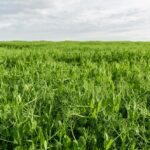When growing pumpkins, there are several infections and diseases that you should watch out for to ensure healthy plant growth. Here are some common ones:
- Powdery Mildew: This fungal disease appears as a white, powdery coating on the leaves and stems of the plant. It can stunt the growth of pumpkins and reduce yields. To prevent powdery mildew, ensure proper air circulation, avoid overhead watering, and consider applying fungicides if necessary.
- Downy Mildew: Downy mildew is another fungal disease that affects pumpkin plants. It causes yellowing of leaves and a fuzzy, grayish growth on the undersides of the leaves. Provide good airflow, avoid excessive moisture on foliage, and consider using fungicides to manage downy mildew.
- Bacterial Wilt: Bacterial wilt is a serious disease transmitted by cucumber beetles. It causes sudden wilting and death of pumpkin vines. Remove and destroy infected plants and control cucumber beetles with insecticides or physical barriers like row covers.
- Anthracnose: Anthracnose is a fungal disease that affects pumpkin fruits, causing sunken, dark lesions with orange spores. To prevent anthracnose, practice crop rotation, avoid overhead watering, and remove and destroy infected plant material.
- Cucumber Mosaic Virus (CMV): CMV is a viral disease that can affect pumpkin plants, causing stunted growth, mottling, and distortion of leaves. Control aphids, which transmit the virus, and consider using virus-resistant pumpkin varieties.
- Fusarium Wilt: Fusarium wilt is a soil-borne fungal disease that causes wilting and yellowing of leaves. Infected plants may eventually die. Practice crop rotation, use disease-free seeds or transplants, and maintain good soil drainage to reduce the risk of Fusarium wilt.
- Phytophthora Blight: Phytophthora blight is a fungal disease that affects pumpkin vines and fruits, causing rotting and collapse. Provide good drainage, avoid overhead watering, and remove and destroy infected plant material to prevent the spread of the disease.
To minimize the risk of infections and diseases, it’s essential to maintain good plant hygiene, provide proper spacing between plants, water at the base of the plants, and regularly monitor your pumpkin plants for any signs of diseases or pests. If you notice any issues, take appropriate measures promptly to protect your crop.
Join 'Farmers Mag' WhatsApp Channel
Get the latest Farming news and tips delivered straight to your WhatsApp
CLICK HERE TO JOIN






